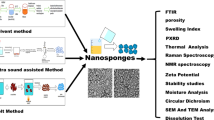Abstract
The present research work compares the effect of microsphere preparation technique on micromeritics and release behaviors of theophylline microspheres. Microspheres were prepared by oil-in oil (O1/O2) emulsion solvent evaporation method (ESE) using different ratios of anhydrous theophylline to cellulose acetate butyrate (CAB). Cyclohexane was used as non-solvent to modify the ESE technique (MESE method) and the effect of non-solvent volume on properties of microspheres was investigated. The obtained microspheres were analyzed in terms of drug content, particle size and encapsulation efficiency. The morphology of microsphere was studied using scanning electron microscope. The solid state of microspheres, theophylline and CAB were investigated using X-ray, FT-IR and DSC. The drug content of microspheres prepared by MESE method was significantly lower (15.54% ± 0.46) than microspheres prepared by ESE method (41.08 ± 0.40%). The results showed that as the amount of cyclohexane was increased from 2 mL to 6 mL the drug content of microspheres was increased from 15.54% to 28.71%. Higher encapsulation efficiencies were obtained for microspheres prepared by ESE method (95.87%) in comparison with MESE method (64.71%). Mean particle size of microsphere prepared by ESE method was not remarkably affected by drug to polymer ratio, whereas in MSES method when the volume of cyclohexane was increased the mean particle size of microsphere was significantly decreased. The ratio of drug to polymer significantly changed the rate of drug release from microspheres and the highest drug release was obtained for the microsphere with high drug to polymer ratio. The amount of cyclohexane did not significantly change the drug release. Although, x-ray showed a small change in crystallinity of theophylline in microspheres, DSC results proved that theophylline in microspheres is in amorphous state. No major chemical interaction between the drug and polymer was reported during the encapsulation process.
Similar content being viewed by others
References
Costa, P., An alternative method to the evaluation of similarity factor in dissolution testing. Int. J. Pharm., 220, 77–83 (2001).
Das, M. K. and Rao, K.R., Microencapsulation of zidovudine by double emulsion solvent diffusion technique using ethylcellulose. Indian J. Pharm. Sci., 69, 244–250 (2007).
Hamishekar, H., Emami, J., Najafabadi, A.R., Gilani, K., Minaiyan, M., Mahdavai, H., and Nokhodchi, A., Particle size design of PLGA microspheres for pulmonary drug delivery: Mathematical modeling and statistical optimization using response surface methodology. J. Microencap., 26, 1–8 (2009).
Jameela, S. R., Suma, N., and Jayakrishnan, A., Protein release from poly(å-caprolactone) microspheres prepared by melt encapsulation and solvent evaporation techniques: a comparative study. J. Biomater. Sci., Polym. Ed., 8, 457–466 (1997).
Kilicarslan, M. and Baykara, T., The effect of the drug/polymer ratio on the properties of verapamil HCL loaded microspheres. Int. J. Pharm., 252, 99–109 (2003).
Lu, W. and Park, T. G., Protein release from poly(lactic-co-glycolic acid) microspheres: protein stability problems, J. Pharm. Sci. Technol., 49, 13–19 (1995).
Mellstand, T., Svedmyr, N., and Fagerstorm, P. O., Absorption of theophylline from conventional and sustained release tablets. Eur. J. Respir. Dis. Suppl. 109, 54–61 (1980).
Miyazaki, Y., Yakou, S., Nagai, T., and Takayama, K., release profiles of theophylline from microspheres consisting of dextran derivatives and cellulose acetate butyrate: effect of polyion complex formation. Drug Dev. Ind. Pharm., 29, 795–804 (2003).
Obaidat, W. M. and Obaidat, I. M., Effect of the dispersion of eudragit S100 powder on the properties of cellulose acetate butyrate microspheres containing theophylline made by the emulsion-solvent evaporation method. J. Microencap., 24, 263–273 (2007).
Obaidat, W. M. and Price, J. C., Preparation and evaluation of eudragite S100 microspheres as pH-sensitive release preparation for piroxicam and theophylline using the emulsionsolvent evaporation method. J. Microencap., 23, 195–202 (2006).
Pignatello, R., Consoli, P., and Puglist, G. In vitro release kinetics of tolmetin from tabletted eudragit microparticles. J. Microencap., 17, 373–383 (2000).
Pongpaibal, Y., Price, J. C., and Whitworth, C. W Preparation and development of controlled release indomethacine microsphere. Drug Dev. Ind. Pharm., 10, 1597–1616 (1984).
Pongpaibal, Y., and Whitworth, C. W., Preparation and in vitro dissolution characteristics of propranolol microcapsules. Int. J. Pharm., 33, 243–248 (1986).
Sayed, H. A. M. and Price, J. C., Tablet properties and dissolution characteristics of compressed cellulose acetate butyrate microcapsules containing succinyl sulfathiazole. Drug Dev. Ind. Pharm., 12, 577–587 (1986).
Soeterboek, A. M. and Jonkman, J. H. G., Clinical pharmacokinetic aspects of theophylline, in: F.W.H.M. Merkus (Ed.), The Serum Concentration of Drugs: Clinical Relevance, Theory and Practice, Excerpta Medica, Amsterdam, pp: 25–259 (1980).
Soppimath, K. S., Kulkarni, A. R., and Aminabhavi, T. M., Development of hollow microspheres as floating controlled-release systems for cardiovascular drugs: preparation and release characteristics. Drug Dev. Ind. Pharm., 27, 507–515 (2001).
Subhaga, C. S., Ravi, K. G., Sunny, M. C., Jayakrishnan, S. A., Evaluation of an aliphatic polyurethane as a micro-sphere matrix for sustained theophylline delivery. J. Microencap., 12, 617–625 (1995).
Sunit, K. S., Abdul-Arif, M., Barik, B. B., and Prakash, C. H. S., Formulation and in vitro evaluation of eudragit® microspheres of stavudine. Tropical J. Pharm. Res., 4, 369–375 (2005).
Varshosaz, J., Kennedy, R. A., and Gipps, E. M., Use of enteric polymers for production of microspheres by extrusion-spheronization. Pharm. Acta Helv., 72, 145–152 (1997).
Wu, J. C., SU, S. G., and Shyu, S. S., Effect of solvent-nonsolvent pairs on the surface morphology and release behaviour of ethycellulose microcapsules prepared by non-solvent-addition phase separation method. J. Microencap., 11, 297–308 (1994).
Author information
Authors and Affiliations
Corresponding author
Rights and permissions
About this article
Cite this article
Jelvehgari, M., Atapour, F. & Nokhodchi, A. Micromeritics and release behaviours of cellulose acetate butyrate microspheres containing theophylline prepared by emulsion solvent evaporation and emulsion non-solvent addition method. Arch. Pharm. Res. 32, 1019–1028 (2009). https://doi.org/10.1007/s12272-009-1707-y
Received:
Revised:
Accepted:
Published:
Issue Date:
DOI: https://doi.org/10.1007/s12272-009-1707-y




